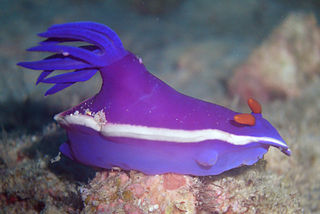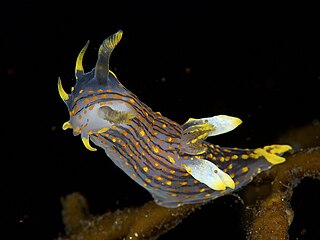
Aplysia is a genus of medium-sized to extremely large sea slugs, specifically sea hares, which are a kind of marine gastropod mollusk.

The Polyceridae are a taxonomic family of sea slugs, dorid nudibranchs, marine gastropod mollusks within the superfamily Polyceroidea.

Hexabranchidae is a family of colourful nudibranchs which contains only a single genus, Hexabranchus, with six species.

Tritoniidae is a taxonomic family of nudibranchs in the suborder Cladobranchia, shell-less marine gastropod molluscs. This family includes some of the largest known nudibranchs, with the NE Atlantic species Tritonia hombergii reaching 20 cm in length. It is the only family in the monotypic superfamily Tritonioidea.

The Pleurobranchidae are a taxonomic family of sea slugs, marine gastropod molluscs in the clade Pleurobranchomorpha.

Chromodoris is a genus of very colourful sea slugs or dorid nudibranchs, marine gastropod molluscs, and the type genus of the family Chromodorididae. Within the genus Chromodoris, there are currently 101 classified species. Species within Chromodoris are commonly found in tropical and subtropical waters, living as members of reef communities and preying primarily on sponges. A molecular phylogeny of the family Chromodorididae resulted in this genus being restricted to a smaller number of species than formerly, most of which have longitudinal black lines on the mantle. Many former members of Chromodoris were transferred to Goniobranchus

Philine is a genus of sea slugs or sea snails, marine gastropod molluscs in the subfamily Philininae of the family Philinidae, the headshield slugs or paper bubbles.

Hypselodoris is a genus of colourful sea slugs or dorid nudibranchs, marine gastropod mollusks in the family Chromodorididae. Modern usage follows a more restricted view of which species belong in this genus so there are numerous genus transfers.

Glossodoris is a genus of sea slugs, dorid nudibranchs, shell-less marine gastropod mollusks in the family Chromodorididae.

Polycera is a genus of sea slugs, specifically nudibranchs, shell-less marine gastropod molluscs in the family Polyceridae.

Flabellina is a genus of sea slugs, specifically aeolid nudibranchs. These animals are marine gastropod molluscs in the family Flabellinidae.

Doris is a genus of sea slugs, specifically dorid nudibranchs. These animals are marine gastropod molluscs in the family Dorididae.

Duvaucelia odhneri, is a species of dendronotid nudibranch. It is a marine gastropod mollusc in the family Tritoniidae.

Risbecia is a genus of colorful sea slugs, dorid nudibranchs, shell-less marine gastropod mollusks in the family Chromodorididae.

Marionia is a genus of sea slugs, specifically dendronotid nudibranchs, marine gastropod molluscs in the family Tritoniidae.

Felimare is a genus of sea slugs, dorid nudibranchs, shell-less marine gastropod molluscs in the subfamily Miamirinae of the family Chromodorididae.

Duvaucelia is a genus of sea slugs, nudibranchs, shell-less marine gastropod molluscs in the family Tritoniidae. It was synonymised with Tritonia until 2020 when a revision of the family Tritoniidae brought it back into use.
Tritonicula is a genus of sea slugs, nudibranchs, shell-less marine gastropod molluscs in the family Tritoniidae. It contains species previously included in Tritonia as a result of a revision of the family Tritoniidae.

















